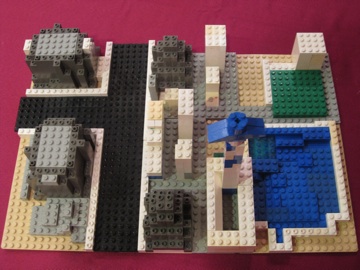Fedora--A Lego Model
When reading Invisible Cities, I was struck by Calvino's description of Fedora (32-33) because of how well it represented our discussion about the different experiences that individuals can have of the same city. Fedora is a place that was once a desirable center of social activity, according to the description. Calvino describes very few architectural elements of the city--he only says that the "real" Fedora is made of gray stone, and he lists the minaret, the avenue for elephants and the "medusa pond" as three fantasy elements from the idealized Fedora. The rest is up to the reader to imagine, and each reader will imagine a slightly different Fedora depending on his or her desires. This description falls under the category of "city and desire," and when Calvino describes tangible elements of Fedora, its most important element is the museum of glass globes that contain miniaturized versions of an idealized Fedora. There are, one can imagine, hundreds of these glass globes, and each visitor at the museum chooses the one that most resembles what he or she desires from a city. Thus, different representations of the same city become equally real to the visitors.
During his description, Calvino describes these miniature Fedoras as "only a toy in a glass globe" (32). This line was the inspiration for the medium of my project, as Lego itself is a plastic toy with which many of us can identify. For those of my classmates viewing my Fedora, Lego may have been an important part of their childhood and thus when they see it, it automatically resonates with the idea of "toy" to which Calvino refers. I played with Lego as a child, creating tiny fantasy cities, buildings and environments for my Lego people to enjoy, and this project was a similar endeavor in many ways.
In my model, you see the three fantasy elements of the minaret, the avenue for elephants and the medusa pond represented, as well as some gray stone buildings (one of which is meant to be the metal building that is the museum). My model thus encompasses both the description of the idealized Fedora as well as the elements from the real, uninteresting, decrepit, abandoned Fedora. I chose to combine the ideal and real version because a crucial message of Calvino's piece is that both the idealized and the real versions of the city are equally important. He writes, "On the map of your empire, O Great Khan, there must be room for the big, stone Fedora and the little Fedoras in the glass globes. Not because they are all equally real, but because all are only assumptions. The one contains what is accepted as necessary when it is not yet so; the others, what is imagined as possible and, a moment later, is possible no longer" (32-33). Both versions are important because they represent extremes. The "real" Fedora represents defeat; we accept cities such as the real Fedora and no longer strive to build fantasy elements that correspond to our desires. The miniature, idealized Fedora shows us what could be possible if we had not given up hope and settled for living in the "real" Fedora. In reality, both elements are represented in cities that we experience in our lives on a daily basis, because every city contains both extremes. This is why I felt it was important to create a model that was a hybrid of the two Fedoras.
*Note--My Powerpoint file was too big, so I am posting two images of the model here and I will be bringing in the model itself as well as the Powerpoint on a flash drive on Tuesday.

Larger versions of images:
 Fedora Image.JPG
Fedora Image.JPG
